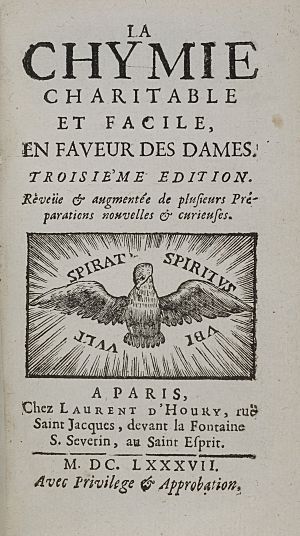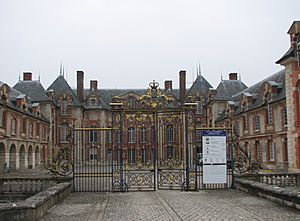Marie Meurdrac facts for kids
Quick facts for kids
Marie Meurdrac
|
|
|---|---|

Frontispiece of La Chymie ... des Dames, 1687 edition
|
|
| Born | c. 1610 Mandres-les-Roses, France
|
| Died | 1680 (aged around 70) |
| Nationality | French |
| Occupation |
|
|
Notable work
|
La Chymie Charitable et Facile, en Faveur des Dames |
Marie Meurdrac (born around 1610, died 1680) was a French chemist and writer. She is famous for her book La Chymie Charitable et Facile, en Faveur des Dames. This title means "Useful and Easy Chemistry, for the Benefit of Ladies."
Her book was one of the first chemistry or alchemy books written by a woman. It was made for everyday women. Marie Meurdrac believed that "minds have no sex." This meant she thought women were just as smart as men. She wanted to share her knowledge, even though some people didn't think women should be educated.
Contents
Marie Meurdrac's Early Life
Marie Meurdrac was born in Mandres-les-Roses, a town near Paris, France. Her family owned land. Her father, Vincent Meurdrac, was a local notary. Her mother was Elisabeth Dovet.
Marie had a younger sister named Catherine, who later wrote her own Memoirs. Marie was a serious child. When she was about 15, in 1625, she married Henri de Vibrac. He was a commander in the guard of Charles de Valois, Duke of Angoulême. Marie then moved to the Château de Grosbois. There, she became good friends with the Countess de Guiche. Marie later dedicated her chemistry book to the Countess.
How Marie Learned and Worked
Marie Meurdrac taught herself about chemistry. She studied books and experiments from other scientists. She also read about alchemy, which was an early form of chemistry.
Her studies included how to do lab work and how to make medicines and beauty products. She even had a list of weights and 106 symbols used in medicine. Marie had her own laboratory. There, she did experiments to create home remedies and beauty items for women. She carefully wrote down all her recipes.
Marie also offered to teach women in her lab. This was for those who felt shy about doing experiments alone. She had a special high-temperature furnace for her experiments. This was rare at the time because it needed special permission from the king. It is thought she got this permission through her friend, the Countess de Guiche.
Her Famous Book: La Chymie Charitable
In 1656 or 1666, Marie Meurdrac published her well-known book, La Chymie Charitable et Facile, en Faveur des Dames. This book was a big deal because it was one of the first chemistry books written by a woman.
The book was very popular. It was printed many times in French. It was also translated into German and Italian. The Faculty of Medicine in Paris approved her work. The book aimed to provide affordable treatments for people who were poor.
What Was in the Book?
The book had six main parts:
- Part 1: Explained basic chemistry ideas, tools, and how to use furnaces.
- Part 2: Focused on medical herbs and medicines made from plants.
- Part 3: Dealt with remedies from animals.
- Part 4: Covered metals.
- Part 5: Showed how to make complex medicines.
- Part 6: Was for women. It taught them how to make beauty products and keep themselves looking good.
Marie wrote in her introduction that she was very careful. She said everything she taught was true and that her remedies had been tested. She also famously wrote, "les esprits n'ont point de sexe," meaning "minds have no sex." She wanted to prove that women could write textbooks and teach others.
Some experts have debated if her book was about alchemy or chemistry. But it was similar to "medical cookery books" popular in Italy. These books often included medical and beauty recipes.
Marie Meurdrac's Ideas on Gender
Marie Meurdrac is seen by some as an early feminist. A feminist is someone who believes in equal rights for women. In her book's introduction, she talked about her struggle. Women at that time were expected to be quiet and not show their knowledge.
However, Marie decided it would be wrong to hide the knowledge God had given her. She believed it could help the world. Her work helped change ideas about women in science. She showed that women could contribute to scientific knowledge.
Marie's Own Words on Women's Minds
In her dedication letter, Marie wrote: "When I started this small book, it was just for me. I wanted to remember what I had learned from much hard work and many experiments. I can't hide that when I finished it, I wanted to publish it. But I also had reasons to keep it hidden. I worried about what others would say.
I thought about this for almost two years. I told myself that teaching was not a woman's job. That a woman should be quiet, listen, and learn, without showing what she knows. That it is too much for her to publish a book. And that such a reputation is not good.
But then I told myself that I am not the first woman to publish something. That a mind has no sex. And if women's minds were trained like men's, and if we spent as much time and money on their education, they could be their equals."
Marie Meurdrac's Impact
Marie Meurdrac's book, La Chymie, interested the famous French playwright Molière. He may have used her work as inspiration for his play Les Femmes Savantes (The Learned Ladies). This play made fun of women who spent too much time on science and studies.
The play suggested that women should not be educated. It showed educated women as annoying. However, Molière's play did not mention chemistry. This might be because his play was written before Marie's book became widely known.
Images for kids
See also
 In Spanish: Marie Meurdrac para niños
In Spanish: Marie Meurdrac para niños






